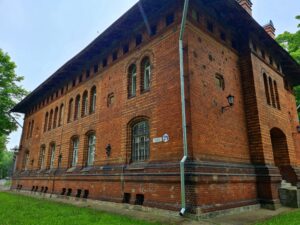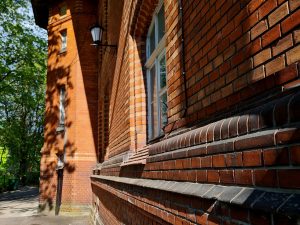The neo-Renaissance style red brick building typical of the era, with two 2-floor apartments, was built in 1896. Of course, the building was designed by the manufacture architect Paul Alisch.
The building is decorated with large arched windows, typical of Kreenholm and light horizontal stripes – after all, assistant directors lived here. By the way, the main entrances to this luxurious residential building in Kreenholm are not located in the front, but on its sides.
We hope that in the coming years this house will become a residential building with a luxurious atmosphere again, because the original imposing interior of the building is well preserved. If you noticed the forged metal elements on the side of the house and thought that these were flagpole holders, then you were mistaken. In fact, they were designed to hold torches.
Five magnificent Kreenholm factory buildings are located on the other side of Joala Street, behind the wall, the three older factories are hidden on Kreenholm Island, behind the Joala and Georgi factories, which are easily visible from the street. You can only enter the territory of the factory with a tour guide because it is private property.
Since 1994, Kreenholm has been owned by Swedish companies. The textile manufacture went bankrupt and stopped completely in 2010. The buildings and the area of historic Kreenholm are managed by the development company Narva Gate OÜ. There is no textile production on the territory of Kreenholm any more, and the huge area is waiting for better time. When textile production stopped, the owner started demolition of the low historic value constructions, which were built during the Soviet period. Currently the owner mainly contributes to the maintenance of the roofs. The size of the historical Kreenholm industrial area is 35 hectares, or almost 5 times the size of the 7.5-hectare Rotermann quarter in Tallinn. This comparison serves to explain why it is taking so long to revive historic Kreenholm.
During World War II, Kreenholm was not significantly damaged, so the beautiful Joala factory on the side of Joala street was back to work in 1945. However, in the Georgi factory, which is right behind it, was launched only in 1962. The Joala factory, which we can see, was built in 1890.
The older factories of the Kreenholm are located on the island of Kreenholm, there we can find the old and new spinning factory and the old weaving factory. The old spinning factory – by the way, made of limestone like the older buildings in Kreenholm – was built surprisingly quickly for its time, in a year and a half. Here, in the oldest building of the factory territory, the Kreenholm cultural quarter is planned to be built. In the course of this project, the territory of Kreenholm factory will be partially opened up. We just need to wait a few more years.







